Evaluation of Landslide Susceptibility Based on CF-SVM in Nujiang Prefecture
Abstract
1. Introduction
2. Materials and Methods
2.1. Overview of the Study Area and Data Sources
2.1.1. Overview of the Study Area
2.1.2. Data Sources
2.2. Models
2.2.1. Deterministic Coefficient Model
2.2.2. SVM Model
2.2.3. CF-SVM Model
2.3. Selection and Grading of Evaluation Factors and Sampling Strategy
2.3.1. Selection of Evaluation Factors
2.3.2. Correlation Analysis of Evaluation Factors
2.3.3. Grading of Evaluation Factors
Land-Use Type
Elevation
Slope
Aspect
Proximity to Rivers
Lithology
Proximity to Faults
Proximity to Road
Precipitation
NDVI
2.3.4. Sampling Strategy of Modeling Samples
2.4. Model Construction and Application
3. Results
3.1. Factor Importance
3.2. Landslide Susceptibility Maps
3.2.1. Evaluation Results of Susceptibility Based on CF Model
3.2.2. The Susceptibility Evaluation Results Based on the SVM Model
3.2.3. Evaluation Results of Susceptibility Based on the Coupling of CF and SVM
3.3. Test and Comparison of Models
4. Discussion
5. Conclusions
Author Contributions
Funding
Institutional Review Board Statement
Informed Consent Statement
Data Availability Statement
Acknowledgments
Conflicts of Interest
References
- Ahmed, B.; Dewan, A. Application of Bivariate and Multivariate Statistical Techniques in Landslide Susceptibility Modeling in Chittagong City Corporation, Bangladesh. Remote Sens. 2017, 9, 304. [Google Scholar] [CrossRef]
- Chang, Z.; Du, Z.; Zhang, F.; Huang, F.; Chen, J.; Li, W.; Guo, Z. Landslide Susceptibility Prediction Based on Remote Sensing Images and GIS: Comparisons of Supervised and Unsupervised Machine Learning Models. Remote Sens. 2020, 12, 502. [Google Scholar] [CrossRef]
- Chen, W.; Shahabi, H.; Shirzadi, A.; Hong, H.; Akgun, A.; Tian, Y.; Liu, J.; Zhu, A.X.; Li, S. Novel hybrid artificial intelligence approach of bivariate statistical-methods-based kernel logistic regression classifier for landslide susceptibility modeling. Bull. Eng. Geol. Environ. 2019, 78, 4397–4419. [Google Scholar] [CrossRef]
- Hussain, M.A.; Chen, Z.; Zheng, Y.; Shoaib, M.; Shah, S.U.; Ali, N.; Afzal, Z. Landslide Susceptibility Mapping Using Machine Learning Algorithm Validated by Persistent Scatterer In-SAR Technique. Sensors 2022, 22, 3119. [Google Scholar] [CrossRef]
- Oh, H.-J.; Pradhan, B. Application of a neuro-fuzzy model to landslide-susceptibility mapping for shallow landslides in a tropical hilly area. Comput. Geosci. 2011, 37, 1264–1276. [Google Scholar] [CrossRef]
- Sabokbar, H.F.; Roodposhti, M.S.; Tazik, E. Landslide susceptibility mapping using geographically-weighted principal component analysis [Geomorphology, 226, 1 December 2014, 15–24]. Geomorphology 2015, 234, 192. [Google Scholar] [CrossRef]
- Shahabi, H.; Hashim, M. Landslide susceptibility mapping using GIS-based statistical models and Remote sensing data in tropical environment. Sci. Rep. 2015, 5, 9899. [Google Scholar] [CrossRef]
- Wang, Z.; Brenning, A. Active-Learning Approaches for Landslide Mapping Using Support Vector Machines. Remote Sens. 2021, 13, 2588. [Google Scholar] [CrossRef]
- Zhou, C.; Yin, K.; Cao, Y.; Li, Y. Landslide Susceptibility Assessment by Applying the Coupling Method of Radial Basis Neural Network and Adaboost:A Case Study from the Three Gorges Reservoir Area. Earth Sci. 2020, 45, 1865–1876. [Google Scholar]
- Huang, F.M. Landslide Displacement Prediction and Susceptibility Evaluation Based on 3S and Artificial Intelligence. Ph.D. Thesis, China University of Geosciences, Wuhan, China, 2017. [Google Scholar]
- Nor Diana, M.I.; Muhamad, N.; Taha, M.R.; Osman, A.; Alam, M.M. Social Vulnerability Assessment for Landslide Haz-ards in Malaysia: A Systematic Review Study. Land 2021, 10, 315. [Google Scholar] [CrossRef]
- Ram, P.; Gupta, V. Landslide hazard, vulnerability, and risk assessment (HVRA), Mussoorie township, lesser himalaya, India. Environ. Dev. Sustain. 2022, 24, 473–501. [Google Scholar] [CrossRef]
- Guo, Z.Z.; Shi, Y.; Huang, F.M.; Fan, X.M.; Huang, J.S. Landslide susceptibility zonation method based on C5.0 decision tree and K-means cluster algorithms to improve the efficiency of risk management. Geosci. Front. 2021, 12, 101249. [Google Scholar] [CrossRef]
- Hu, Z.Y.; Luo, W.Q.; Yan, E.C.; Tan, Y.S. Evaluation of geological hazard susceptibility in Yingshan County based on im-proved analytic hierarchy process. Saf. Environ. Eng. 2018, 25, 28–32. [Google Scholar] [CrossRef]
- Cao, P.Y.; Hu, S.; Yang, D.D.; Cao, M.M. Risk assessment of Xi’an geological disaster based on fuzzy hierarchy analysis. J. Arid. Land Resour. Environ. 2017, 31, 136–142. [Google Scholar] [CrossRef]
- Chen, F.; Cai, C.; Li, X.S.; Sun, T.; Qian, Q. Landslide susceptibility evaluation based on information content and neural net-work model. Chin. J. Rock Mech. Eng. 2020, 39, 2859–2870. [Google Scholar] [CrossRef]
- Ozdemir, A.; Altural, T. A comparative study of frequency ratio, weights of evidence and logistic regression methods for landslide susceptibility mapping: Sultan Mountains, SW Turkey. J. Asian Earth Sci. 2013, 64, 180–197. [Google Scholar] [CrossRef]
- Chen, W.; Li, Y. GIS-based evaluation of landslide susceptibility using hybrid computational intelligence models. Catena 2020, 195, 104777. [Google Scholar] [CrossRef]
- Hong, H.; Chen, W.; Xu, C.; Youssef, A.M.; Pradhan, B.; Dieu Tien, B. Rainfall-induced landslide susceptibility assessment at the Chongren area (China) using frequency ratio, certainty factor, and index of entropy. Geocarto Int. 2017, 32, 139–154. [Google Scholar] [CrossRef]
- Sun, D.L.; Xu, J.H.; Wen, H.J.; Wang, D.Z. Assessment of landslide susceptibility mapping based on Bayesian hyperparameter optimization: A comparison between logistic regression and random forest. Eng. Geol. 2021, 281, 105972. [Google Scholar] [CrossRef]
- Huang, F.M.; Shi, Y.; Ouyang, W.P.; Hong, A.Y.; Zeng, Z.Q.; Xu, F.G. Landslide susceptibility prediction based on evidence weight and Chi-square automatic interactive detection decision tree. J. Civ. Environ. Eng. (Chin. Engl.) 2022, 44, 16–28. [Google Scholar]
- Wang, G.; Lei, X.; Chen, W.; Shahabi, H.; Shirzadi, A. Hybrid Computational Intelligence Methods for Landslide Suscep-tibility Mapping. Symmetry 2020, 12, 325. [Google Scholar] [CrossRef]
- Dong Van, D.; Jaafari, A.; Bayat, M.; Mafi-Gholami, D.; Qi, C.; Moayedi, H.; Tran Van, P.; Hai-Bang, L.; Tien-Thinh, L.; Phan Trong, T.; et al. A spatially explicit deep learning neural network model for the prediction of landslide susceptibility. Catena 2020, 188, 104451. [Google Scholar] [CrossRef]
- Tehrany, M.S.; Pradhan, B.; Mansor, S.; Ahmad, N. Flood susceptibility assessment using GIS-based support vector machine model with different kernel types. Catena 2015, 125, 91–101. [Google Scholar] [CrossRef]
- Chen, W.; Xie, X.; Peng, J.; Shahabi, H.; Hong, H.; Dieu Tien, B.; Duan, Z.; Li, S.; Zhu, A.X. GIS-based landslide susceptibility evaluation using a novel hybrid integration approach of bivariate statistical based random forest method. Catena 2018, 164, 135–149. [Google Scholar] [CrossRef]
- Chen, Y.; Liu, Z.B.; Liu, S.Y.; Cai, G.J.; Tong, L.Y. Construction risk identification of long span shallow buried highway tunnel based on analytic hierarchy process. Chin. J. Geotech. Eng. 2011, 33, 198–202. [Google Scholar]
- Ali, S.; Biermanns, P.; Haider, R.; Reicherter, K. Landslide susceptibility mapping by using a geographic information system (GIS) along the China-Pakistan Economic Corridor (Karakoram Highway), Pakistan. Nat. Hazards Earth Syst. Sci. 2019, 19, 999–1022. [Google Scholar] [CrossRef]
- Klose, M.; Gruber, D.; Damm, B.; Gerold, G. Spatial databases and GIS as tools for regional landslide susceptibility modeling. Z. Fur Geomorphol. 2014, 58, 1–36. [Google Scholar] [CrossRef]
- Niu, R.; Peng, L.; Ye, R.; Wu, X. Landslide Susceptibility Assessment Based on Rough Sets and Support Vector Machine. J. Jilin Univ. Earth Sci. Ed. 2012, 42, 430–439. [Google Scholar]
- Wu, X.; Ren, F.; Niu, R. Landslide susceptibility assessment using object mapping units, decision tree, and support vector machine models in the Three Gorges of China. Environ. Earth Sci. 2014, 71, 4725–4738. [Google Scholar] [CrossRef]
- Tie, Y.B.; Ruan, C.F.; Yang, S.; Zeng, B.; Zhang, H.B.; Li, F.Q.; Sun, J.F.; He, Z.Q. Characteristics and formation mechanism of the "May 25" rainstorm induced geological disasters in Gongshan County, Yunnan Province. Bull. Soil Water Conserv. 2021, 41, 10–15. [Google Scholar] [CrossRef]
- Hao, X.Z.; Li, Y.M. Analysis of impoverishment factors and countermeasures in Nujiang Prefecture. J. Yunnan Univ. Nat. Sci. Ed. 2007, 29, 166–172. [Google Scholar]
- Shen, D.; Shi, Z.; Peng, M.; Zhang, L.; Zhu, Y. Preliminary analysis of a rainfall-induced landslide hazard chain in Enshi City, Hubei Province, China in July 2020. Landslides 2021, 18, 509–512. [Google Scholar] [CrossRef]
- Huang, F.; Zhang, J.; Zhou, C.; Wang, Y.; Huang, J.; Zhu, L. A deep learning algorithm using a fully connected sparse autoencoder neural network for landslide susceptibility prediction. Landslides 2020, 17, 217–229. [Google Scholar] [CrossRef]
- Chen, W.; Chen, X.; Peng, J.; Panahi, M.; Lee, S. Landslide susceptibility modeling based on ANFIS with teach-ing-learning-based optimization and Satin bowerbird optimizer. Geosci. Front. 2021, 12, 93–107. [Google Scholar] [CrossRef]
- Pandey, V.K.; Pourghasemi, H.R.; Sharma, M.C. Landslide susceptibility mapping using maximum entropy and support vector machine models along the highway corridor, Garhwal Himalaya. Geocarto Int. 2020, 35, 168–187. [Google Scholar] [CrossRef]
- Wang, H.B.; Liu, G.J.; Xu, W.Y.; Wang, G.H. GIS-based landslide hazard assessment: An overview. Prog. Phys. Geogr. Earth Environ. 2005, 29, 548–567. [Google Scholar] [CrossRef]
- Yong, C.; Dong, J.; Fei, G.; Bin, T.; Tao, Z.; Hao, F.; Li, W.; Qinghua, Z. Review of landslide susceptibility assessment based on knowledge mapping. Stoch. Environ. Res. Risk Assess. 2022, 36, 2399–2417. [Google Scholar] [CrossRef]
- He, J.; Li, B. Analysis of main inducing factors of landslide in Lushui County, Nujiang Prefecture. J. Kunming Univ. Sci. Technol. Sci. Technol. 2005, 30, 1–4. [Google Scholar]
- Tan, S.C.; Jin, Y.Z.; Hu, X.G.; Jiang, S.D.; Feng, L. Design and establishment of spatial database for meteorological forecast and early warning of slope geological hazards. J. Earth 2012, 33, 812–818. [Google Scholar]
- Hu, J.; Min, Y.; Li, H.H.; Xu, Y.J.; Li, C.; Li, X. Study on optimization of fine meteorological risk warning model for geological hazards in Yunnan Province. Sci. Disaster 2016, 31, 110–115. [Google Scholar]
- Li, Y.M.; Xie, Y.Y.; Jiang, D.M.; Duan, Y.P. Study on the sensitivity of environmental factors for geological hazards in Nujiang Prefecture. Res. Soil Water Conversat. 2018, 25, 300–305. [Google Scholar] [CrossRef]
- Yao, Y.W.; Liu, W.; Fang, N. Characteristics and prevention countermeasures of geological disasters in Lanping County, Nujiang Prefecture, Yunnan Province. Yunnan Geol. 2019, 38, 483–488. [Google Scholar]
- Dikshit, A.; Sarkar, R.; Pradhan, B.; Acharya, S.; Alamri, A.M. Spatial Landslide Risk Assessment at Phuentsholing, Bhutan. Geosciences 2020, 10, 131. [Google Scholar] [CrossRef]
- Chen, L.; Li, L.; Wu, F.; Xu, Y. Evaluation of the Geological Hazard Vulnerability in the Beiliu City Based on GIS and In-formation Value Model. Earth Environ. 2020, 48, 471–479. [Google Scholar]
- Li, Y.; Chen, L.; Yin, K.; Zhang, Y.; Gui, L. Quantitative risk analysis of the hazard chain triggered by a landslide and the generated tsunami in the Three Gorges Reservoir area. Landslides 2021, 18, 667–680. [Google Scholar] [CrossRef]
- Bruzon, A.G.; Arrogante-Funes, P.; Arrogante-Funes, F.; Martin-Gonzalez, F.; Novillo, C.J.; Fernandez, R.R.; Vazquez-Jimenez, R.; Alarcon-Paredes, A.; Alonso-Silverio, G.A.; Cantu-Ramirez, C.A.; et al. Landslide Susceptibility Assessment Using an AutoML Framework. Int. J. Environ. Res. Public Health 2021, 18, 10971. [Google Scholar] [CrossRef]
- Yang, X.; Liu, R.; Yang, M.; Chen, J.J.; Liu, T.Q.; Yang, Y.T.; Chen, W.; Wang, Y.T. Incorporating Landslide Spatial In-formation and Correlated Features among Conditioning Factors for Landslide Susceptibility Mapping. Remote Sens. 2021, 13, 2166. [Google Scholar] [CrossRef]
- Bayat, M.; Ghorbanpour, M.; Zare, R.; Jaafari, A.; Pham, B.T. Application of artificial neural networks for predicting tree survival and mortality in the Hyrcanian forest of Iran. Comput. Electron. Agric. 2019, 164, 104929. [Google Scholar] [CrossRef]
- Bui, D.T.; Shahabi, H.; Omidvar, E.; Shirzadi, A.; Geertsema, M.; Clague, J.J.; Khosravi, K.; Pradhan, B.; Pham, B.T.; Chapi, K.; et al. Shallow Landslide Prediction Using a Novel Hybrid Functional Machine Learning Algorithm. Remote Sens. 2019, 11, 931. [Google Scholar] [CrossRef]
- Hong, H.Y.; Liu, J.Z.; Zhu, A.X.; Shahabi, H.; Pham, B.T.; Chen, W.; Pradhan, B.; Bui, D.T. A novel hybrid integration model using support vector machines and random subspace for weather-triggered landslide susceptibility assessment in the Wuning area (China). Environ. Earth Sci. 2017, 76, 652. [Google Scholar] [CrossRef]
- Hong, H.Y.; Liu, J.Z.; Bui, D.T.; Pradhan, B.; Acharya, T.D.; Pham, B.T.; Zhu, A.X.; Chen, W.; Bin Ahmad, B. Landslide susceptibility mapping using J48 Decision Tree with AdaBoost, Bagging and Rotation Forest ensembles in the Guangchang area (China). Catena 2018, 163, 399–413. [Google Scholar] [CrossRef]
- Hong, H.Y.; Pradhan, B.; Xu, C.; Tien Bui, D. Spatial prediction of landslide hazard at the Yihuang area (China) using two-class kernel logistic regression, alternating decision tree and support vector machines. Catena 2015, 133, 266–281. [Google Scholar] [CrossRef]
- Liu, J.K.; Shih, P.T.Y. Topographic Correction of Wind-Driven Rainfall for Landslide Analysis in Central Taiwan with Validation from Aerial and Satellite Optical Images. Remote Sens. 2013, 5, 2571–2589. [Google Scholar] [CrossRef]
- Shahabi, H.; Hashim, M.; Bin Ahmad, B. Remote sensing and GIS-based landslide susceptibility mapping using frequency ratio, logistic regression, and fuzzy logic methods at the central Zab basin, Iran. Environ. Earth Sci. 2015, 73, 8647–8668. [Google Scholar] [CrossRef]
- Shirzadi, A.; Shahabi, H.; Chapi, K.; Bui, D.T.; Pham, B.T.; Shahedi, K.; Bin Ahmad, B. A comparative study between popular statistical and machine learning methods for simulating volume of landslides. Catena 2017, 157, 213–226. [Google Scholar] [CrossRef]
- Bui, D.T.; Shirzadi, A.; Shahabi, H.; Geertsema, M.; Omidvar, E.; Clague, J.J.; Pham, B.T.; Dou, J.; Asl, D.T.; Bin Ahmad, B.; et al. New Ensemble Models for Shallow Landslide Susceptibility Modeling in a Semi-Arid Watershed. Forests 2019, 10, 743. [Google Scholar] [CrossRef]
- Nhu, V.H.; Shirzadi, A.; Shahabi, H.; Singh, S.K.; Al-Ansari, N.; Clague, J.J.; Jaafari, A.; Chen, W.; Miraki, S.; Dou, J.; et al. Shallow Landslide Susceptibility Mapping: A Comparison between Logistic Model Tree, Logistic Regression, Naive Bayes Tree, Artificial Neural Network, and Support Vector Machine Algorithms. Int. J. Environ. Res. Public Health 2020, 17, 2749. [Google Scholar] [CrossRef]
- Pham, B.T.; Bui, D.T.; Prakash, I.; Dholakia, M.B. Hybrid integration of Multilayer Perceptron Neural Networks and ma-chine learning ensembles for landslide susceptibility assessment at Himalayan area (India) using GIS. Catena 2017, 149, 52–63. [Google Scholar] [CrossRef]
- Pham, B.T.; Prakash, I.; Singh, S.K.; Shirzadi, A.; Shahabi, H.; Tran, T.T.G.; Buig, D.T. Landslide susceptibility modeling using Reduced Error Pruning Trees and different ensemble techniques: Hybrid machine learning approaches. Catena 2019, 175, 203–218. [Google Scholar] [CrossRef]
- Zhou, X.Z.; Wen, H.J.; Li, Z.W.; Zhang, H.; Zhang, W.G. An interpretable model for the susceptibility of rainfall-induced shallow landslides based on SHAP and XGBoost. Geocarto Int. 2022, 1–27. [Google Scholar] [CrossRef]
- Devkota, K.C.; Regmi, A.D.; Pourghasemi, H.R.; Yoshida, K.; Pradhan, B.; Ryu, I.C.; Dhital, M.R.; Althuwaynee, O.F. Landslide susceptibility mapping using certainty factor, index of entropy and logistic regression models in GIS and their comparison at Mugling-Narayanghat road section in Nepal Himalaya. Nat. Hazards 2013, 65, 135–165. [Google Scholar] [CrossRef]



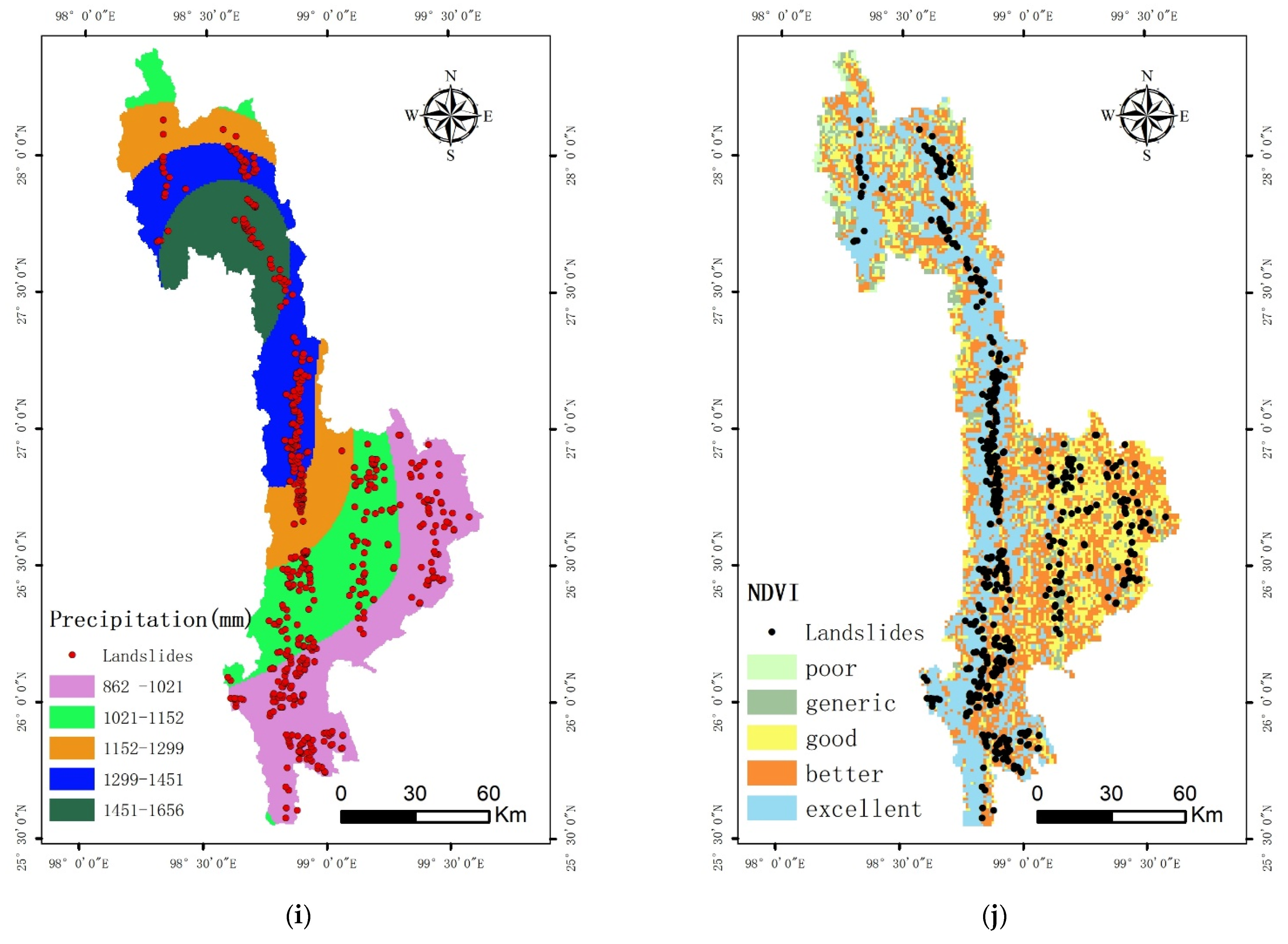
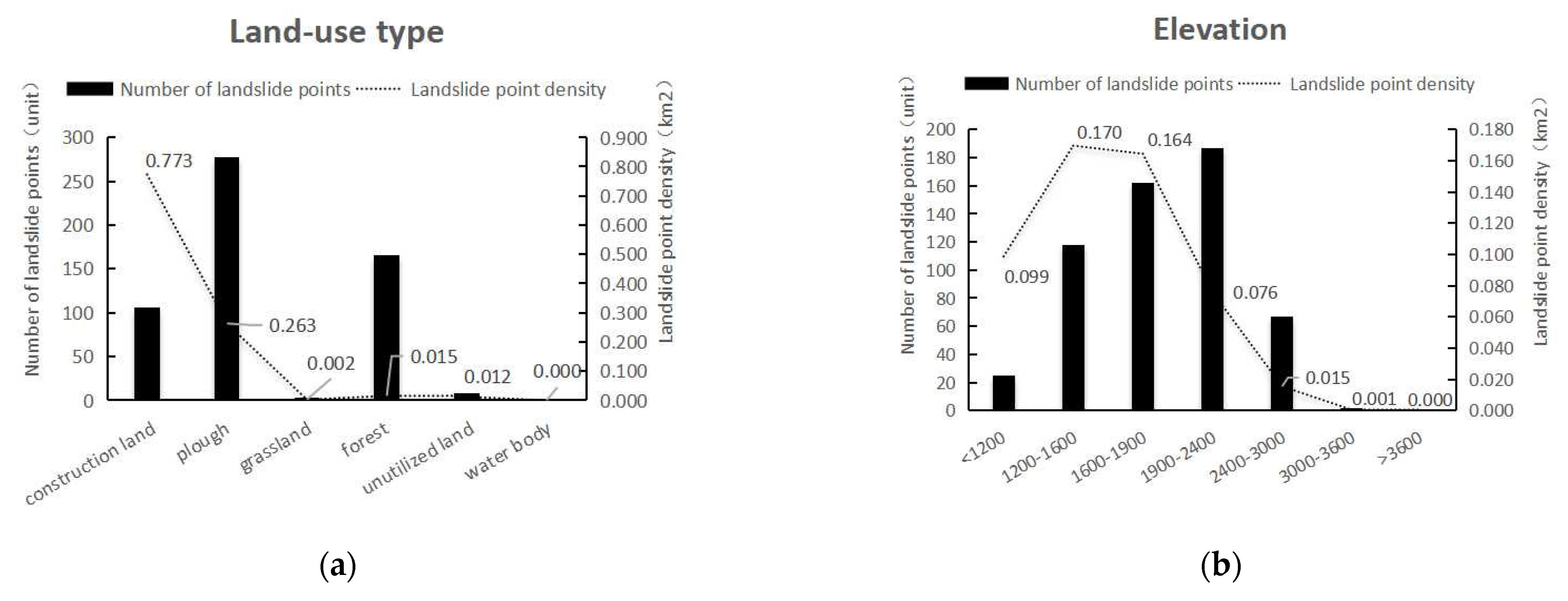

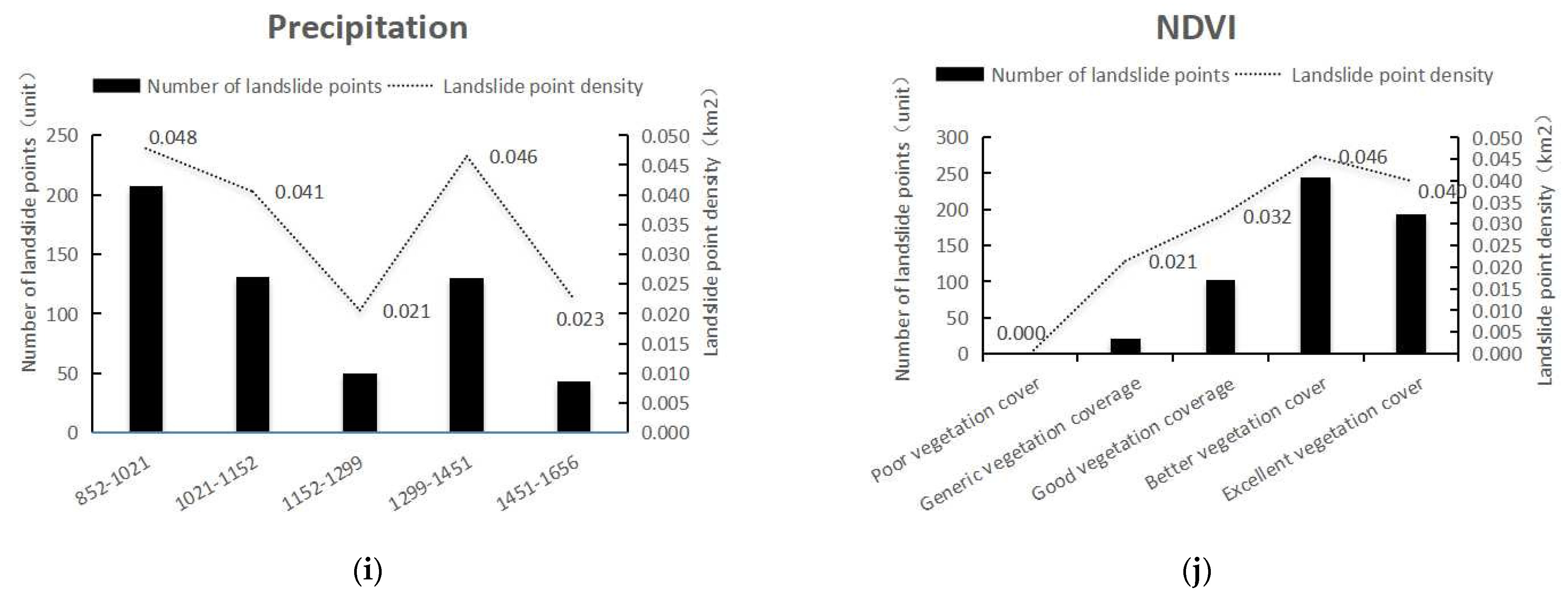
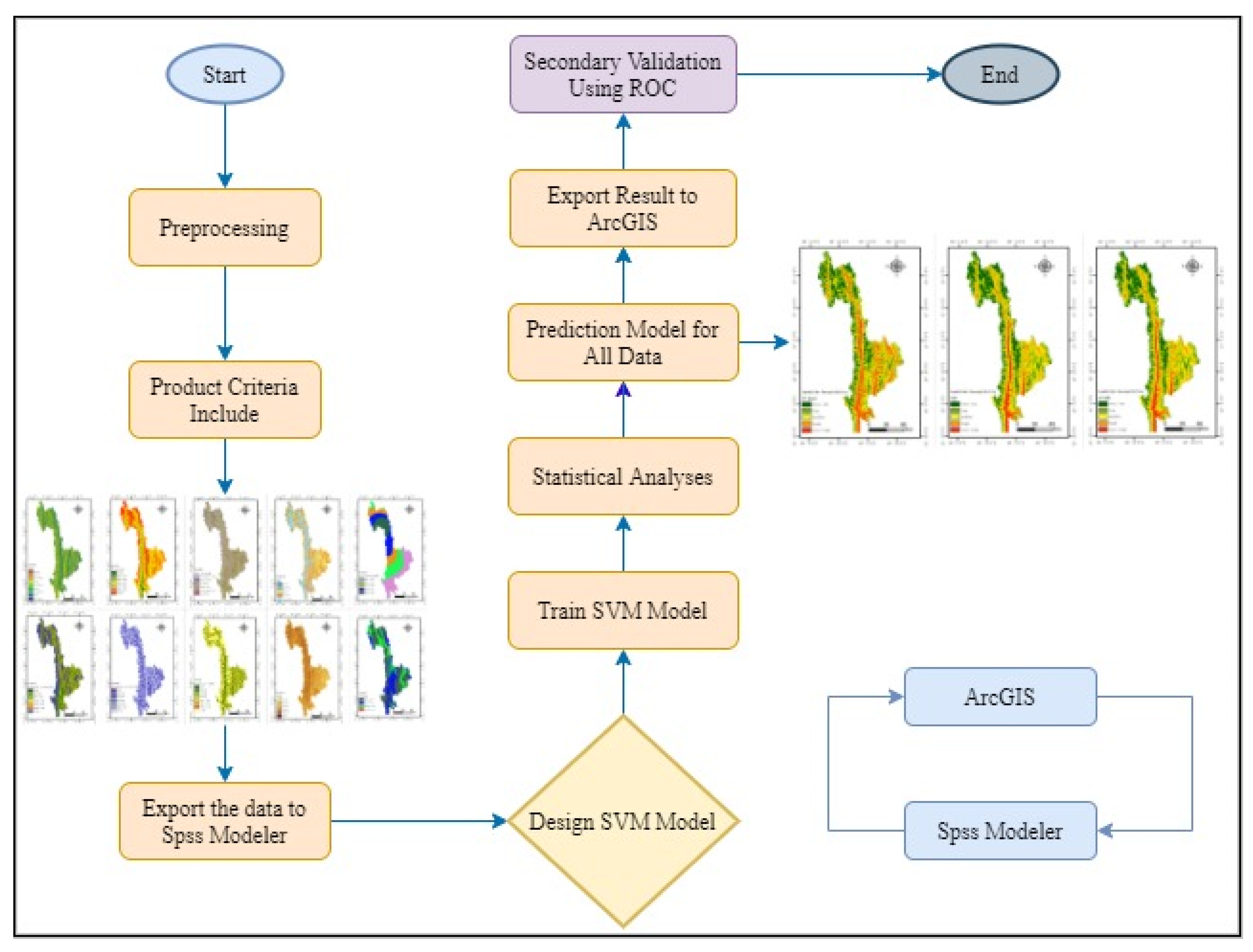

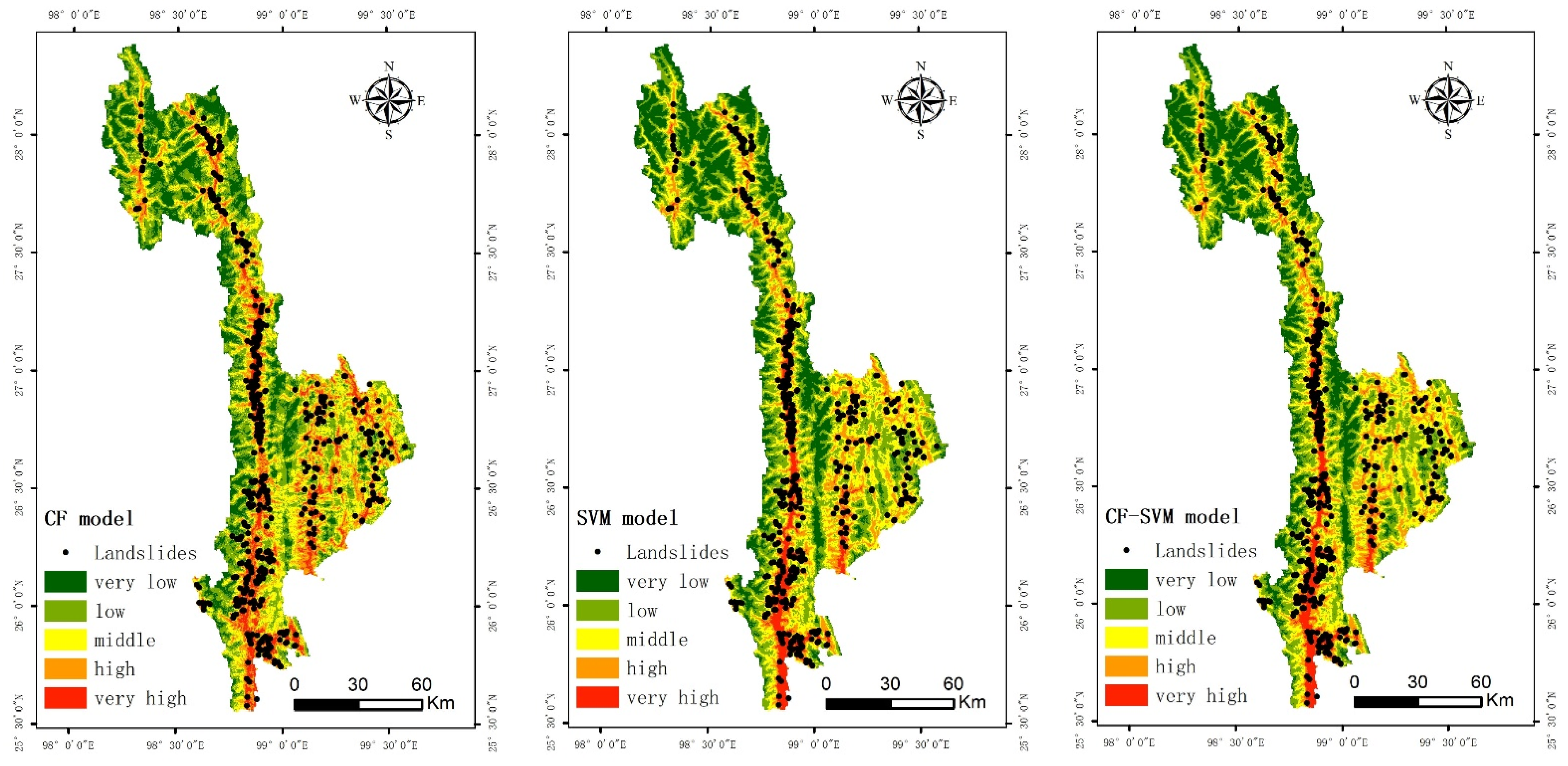
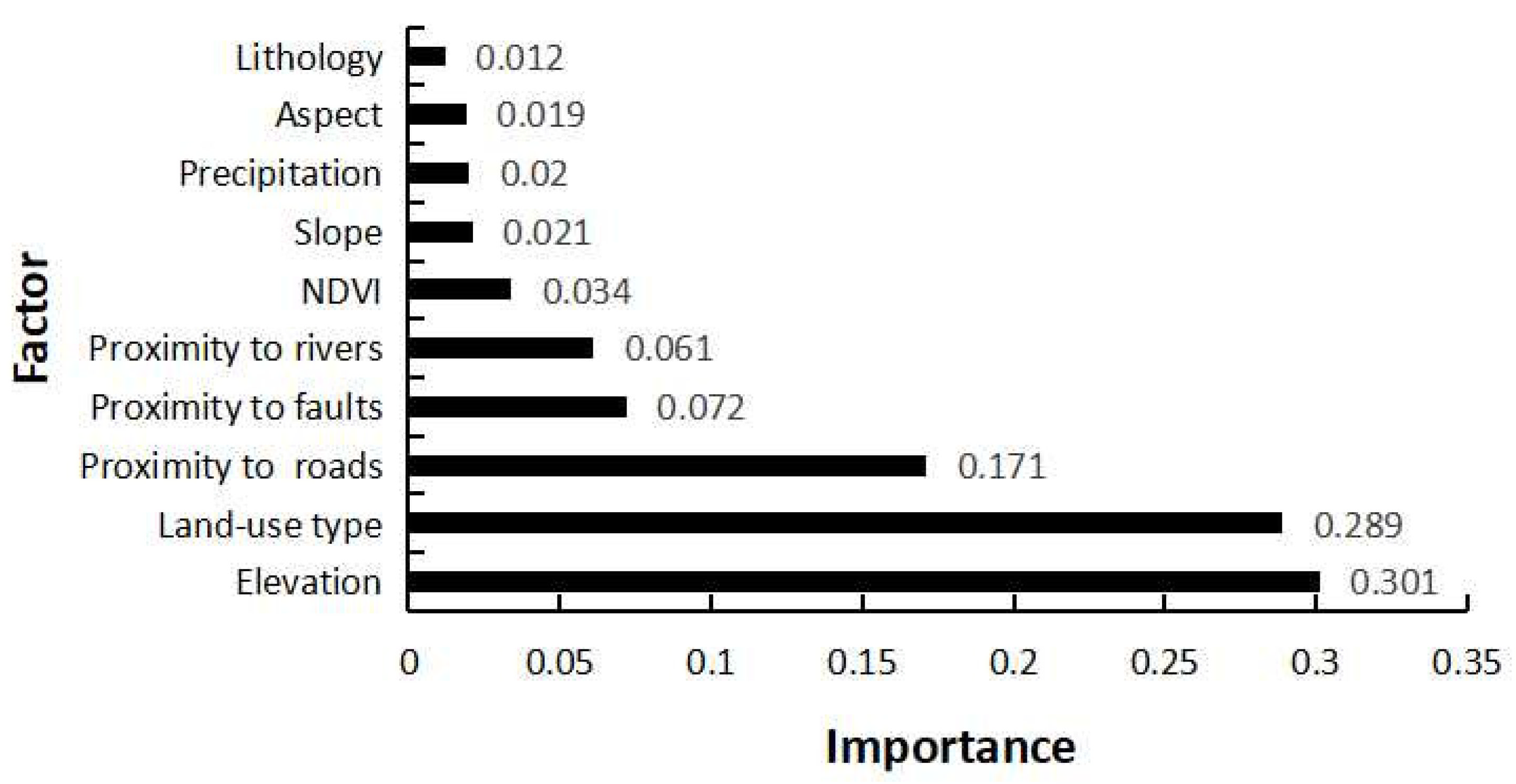

| Conditioning Factor | Source | Scale | Classification Method |
|---|---|---|---|
| Elevation | DEM was derived from ASTER GDEM data of the Geospatial Data Cloud (http://www.gscloud.cn/ (accessed on 25 January 2022).) | 30 × 30 m | Manual |
| Aspect | Manual | ||
| Slope | Manual | ||
| Lithology | Geological map provided by Nujiang State Land and Land Bureau. | 1:250,000 | Lithological units |
| Proximity to faults | Equal interval | ||
| Proximity to rivers | The National Basic Geographic Information Database (https://wwwngcc.cn/ (accessed on 12 November 2021).) | -- | Equal interval |
| Proximity to road | -- | Equal interval | |
| NDVI | The normalized difference vegetation index (NDVI) data were obtained from NASA (https://www.nasa.gov/ (accessed on 5 November 2021).) | 250 × 250 m | Natural breaks |
| Precipitation | The meteorological data were procured from the Nujiang Meteorological Bureau and Water Bureau. | -- | Natural breaks |
| Land-use type | The land-use type data were carried out based on the Landsat 8 OLI/TIRS data of Geospatial Data Cloud (http://www.gscloud.cn/ (accessed on 25 December 2020).) | The interpretation accuracy reached 94.17%. | Land-cover unit |
| Factor | Elevation | Aspect | Slope | Lithology | Proximity to Faults | Proximity to Rivers | Proximity to Road | NDVI | Precipitation | Land-Use Type | Agrotype |
|---|---|---|---|---|---|---|---|---|---|---|---|
| Elevation | 1.000 | ||||||||||
| Aspect | 0.070 | 1.000 | |||||||||
| Slope | −0.095 | −0.046 | 1.000 | ||||||||
| Lithology | 0.413 | 0.078 | −0.037 | 1.000 | |||||||
| Proximity to faults | 0.054 | 0.031 | −0.019 | 0.170 | 1.000 | ||||||
| Proximity to rivers | 0.074 | 0.078 | 0.036 | 0.109 | −0.059 | 1.000 | |||||
| Proximity to road | 0.139 | 0.092 | 0.007 | 0.109 | 0.063 | 0.034 | 1.000 | ||||
| NDVI | 0.216 | 0.048 | −0.132 | 0.092 | −0.045 | −0.001 | −0.008 | 1.000 | |||
| Precipitation | −0.160 | −0.138 | 0.082 | −0.309 | 0.026 | 0.105 | −0.066 | −0.077 | 1.000 | ||
| Land-use type | −0.065 | −0.009 | 0.193 | −0.052 | −0.020 | 0.128 | 0.032 | −0.107 | 0.092 | 1.000 | |
| Agrotype | 0.371 | −0.009 | −0.105 | 0.065 | 0.250 | 0.131 | 0.048 | 0.184 | 0.068 | 0.121 | 1.000 |
| Factor | Classification | Area | Number of Landslide Points | pa | ps | CF |
|---|---|---|---|---|---|---|
| Slope | 0–10° | 731.0079 | 30 | 0.0410 | 0.0382 | 0.0731 |
| 10–20° | 2240.5428 | 116 | 0.0518 | 0.0382 | 0.2735 | |
| 20–30° | 3820.0815 | 187 | 0.0490 | 0.0382 | 0.2293 | |
| 30–40° | 4425.603 | 153 | 0.0346 | 0.0382 | −0.0973 | |
| 40–50° | 2680.7157 | 63 | 0.0235 | 0.0382 | −0.3933 | |
| >50° | 805.0491 | 12 | 0.0149 | 0.0382 | −0.6186 | |
| Aspect | Plane | 22.2255 | 0 | 0.0000 | 0.0382 | −1.0000 |
| North | 1886.0004 | 40 | 0.0212 | 0.0382 | −0.4538 | |
| Northeast | 1702.0764 | 68 | 0.0400 | 0.0382 | 0.0467 | |
| East | 1852.425 | 100 | 0.0540 | 0.0382 | 0.3048 | |
| Southeast | 1806.8571 | 75 | 0.0415 | 0.0382 | 0.0840 | |
| South | 1907.3826 | 56 | 0.0294 | 0.0382 | −0.2375 | |
| Southwest | 1849.5159 | 66 | 0.0357 | 0.0382 | −0.0671 | |
| West | 1862.0028 | 96 | 0.0516 | 0.0382 | 0.2703 | |
| Northwest | 1814.5143 | 60 | 0.0331 | 0.0382 | −0.1379 | |
| Elevation | <1200 | 253.4256 | 25 | 0.0986 | 0.0382 | 0.6375 |
| 1200–1600 | 695.9151 | 118 | 0.1696 | 0.0382 | 0.8057 | |
| 1600–1900 | 985.4766 | 162 | 0.1644 | 0.0382 | 0.7984 | |
| 1900–2400 | 2467.7622 | 187 | 0.0758 | 0.0382 | 0.5162 | |
| 2400–3000 | 4342.7025 | 67 | 0.0154 | 0.0382 | −0.6050 | |
| 3000–3600 | 3874.6638 | 2 | 0.0005 | 0.0382 | −0.9870 | |
| >3600 | 2083.0542 | 0 | 0.0000 | 0.0382 | −1.0000 | |
| Proximity to rivers | 0–200 | 1610.7471 | 94 | 0.0584 | 0.0382 | 0.3599 |
| 200–400 | 1539.6921 | 119 | 0.0773 | 0.0382 | 0.5264 | |
| 400–600 | 1476.4599 | 84 | 0.0569 | 0.0382 | 0.3424 | |
| 600–800 | 1412.6364 | 90 | 0.0637 | 0.0382 | 0.4170 | |
| 800–1000 | 1348.4016 | 66 | 0.0489 | 0.0382 | 0.2292 | |
| 1000–1200 | 1273.5279 | 51 | 0.0400 | 0.0382 | 0.0491 | |
| >1200 | 6041.535 | 57 | 0.0094 | 0.0382 | −0.7599 | |
| Lithology | Weak rock group | 7073.2944 | 230 | 0.0325 | 0.0382 | −0.1528 |
| Hard rock group | 4066.362 | 148 | 0.0364 | 0.0382 | −0.0479 | |
| Harder rock group | 3545.0187 | 183 | 0.0516 | 0.0382 | 0.2712 | |
| Loose rock group | 18.3249 | 0 | 0.0000 | 0.0382 | −1.0000 | |
| Proximity to faults | <400 | 1764.5994 | 94 | 0.0533 | 0.0382 | 0.2950 |
| 400–800 | 1569.7656 | 119 | 0.0758 | 0.0382 | 0.5164 | |
| 800–1200 | 1359.7416 | 84 | 0.0618 | 0.0382 | 0.3975 | |
| 1200–1600 | 1274.3034 | 90 | 0.0706 | 0.0382 | 0.4780 | |
| 1600–2000 | 999.1170 | 66 | 0.0661 | 0.0382 | 0.4392 | |
| 2000–2400 | 844.9938 | 51 | 0.0604 | 0.0382 | 0.3824 | |
| >2400 | 6890.4792 | 57 | 0.0083 | 0.0382 | −0.7897 | |
| NDVI | Poor vegetation cover | 289.2655 | 0 | 0.0000 | 0.0382 | −1.0000 |
| Average vegetation coverage | 980.5989 | 21 | 0.0214 | 0.0382 | −0.4483 | |
| Good vegetation coverage | 3216.5431 | 102 | 0.0317 | 0.0382 | −0.1744 | |
| Excellent vegetation cover | 5367.6063 | 245 | 0.0456 | 0.0382 | 0.1706 | |
| Very excellent vegetation cover | 4832.6326 | 193 | 0.0399 | 0.0382 | 0.0464 | |
| Proximity to road | 0–200 | 1753.1496 | 275 | 0.1569 | 0.0382 | 0.7868 |
| 200–400 | 1560.8115 | 100 | 0.0641 | 0.0382 | 0.4205 | |
| 400–600 | 1390.5945 | 45 | 0.0324 | 0.0382 | −0.1570 | |
| 600–800 | 1249.3899 | 33 | 0.0264 | 0.0382 | −0.3161 | |
| 800–1000 | 1111.7763 | 29 | 0.0261 | 0.0382 | −0.3248 | |
| 1000–1200 | 1087.8549 | 31 | 0.0285 | 0.0382 | −0.2606 | |
| 1200–1400 | 863.1207 | 18 | 0.0209 | 0.0382 | −0.4631 | |
| >1400 | 5686.3026 | 30 | 0.0053 | 0.0382 | −0.8663 | |
| Land-use type | Construction land | 137.1537 | 106 | 0.7729 | 0.0382 | 0.9883 |
| Plowland | 1056.7953 | 278 | 0.2631 | 0.0382 | 0.8889 | |
| Grassland | 1206.9702 | 3 | 0.0025 | 0.0382 | −0.9372 | |
| Forest | 10918.0086 | 166 | 0.0152 | 0.0382 | −0.6108 | |
| Unutilized land | 666.0549 | 8 | 0.0120 | 0.0382 | −0.6935 | |
| Water body | 718.0173 | 0 | 0.0000 | 0.0382 | −1.0000 | |
| Precipitation | 852–1021 | 4331.9367 | 207 | 0.0478 | 0.0382 | 0.2095 |
| 1021–1152 | 3233.5686 | 131 | 0.0405 | 0.0382 | 0.0605 | |
| 1152–1299 | 2430.3624 | 50 | 0.0206 | 0.0382 | −0.4705 | |
| 1299–1451 | 2797.758 | 130 | 0.0465 | 0.0382 | 0.2284 | |
| 1451–1656 | 1909.3743 | 43 | 0.0225 | 0.0382 | −0.4192 |
| Degree of Susceptibility | Area (km2) | Ratio (%) | Number of Disasters (Unit) | Ratio% | Disaster Point Density (Unit/km2) |
|---|---|---|---|---|---|
| Very low susceptibility | 2516.5000 | 17.12% | 0.0000 | 0.0000 | 0.0000 |
| Low susceptibility | 4005.7900 | 27.24% | 2.0000 | 0.36% | 0.0005 |
| Moderate susceptibility | 3825.0400 | 26.02% | 27.0000 | 4.81% | 0.0071 |
| High susceptibility | 2881.4300 | 19.60% | 150.0000 | 26.74% | 0.0521 |
| Very high susceptibility | 1474.2400 | 10.03% | 382.0000 | 68.09% | 0.2591 |
| Total | 14,703.0000 | 1.0000 | 561.0000 | 1.0000 | — |
| Degree of Susceptibility | Area (km2) | Ratio (%) | Number of Disasters (Unit) | Ratio% | Disaster Point Density (Unit/km2) |
|---|---|---|---|---|---|
| Very low susceptibility | 2914.3200 | 19.82% | 0.0000 | 0.0000 | 0.0000 |
| Low susceptibility | 4116.1100 | 28.00% | 7.0000 | 1.25% | 0.0017 |
| Moderate susceptibility | 3865.6500 | 26.29% | 82.0000 | 14.62% | 0.0212 |
| High susceptibility | 2678.8600 | 18.22% | 173.0000 | 30.84% | 0.0646 |
| Very high susceptibility | 1128.0600 | 7.67% | 299.0000 | 53.30% | 0.2651 |
| Total | 10,473.00 | 1.0000 | 561 | 1.0000 | — |
| Degree of Susceptibility | Area (km2) | Ratio (%) | Number of Disasters (Unit) | Ratio% | Disaster Point Density (Unit/km2) |
|---|---|---|---|---|---|
| Very low susceptibility | 5238.37002 | 35.63% | 0.0000 | 0.0000 | 0.0000 |
| Low susceptibility | 4427.62662 | 30.11% | 22 | 3.92% | 0.0049 |
| Moderate susceptibility | 1557.94512 | 10.10% | 69 | 12.30% | 0.0442 |
| High susceptibility | 2435.83212 | 16.57%1 | 154 | 27.45% | 0.0632 |
| Very high susceptibility | 1043.22612 | 7.09% | 316 | 56.33% | 0.3029 |
| Total | 10,473.00 | 1.0000 | 561 | 1.0000 | — |
Publisher’s Note: MDPI stays neutral with regard to jurisdictional claims in published maps and institutional affiliations. |
© 2022 by the authors. Licensee MDPI, Basel, Switzerland. This article is an open access article distributed under the terms and conditions of the Creative Commons Attribution (CC BY) license (https://creativecommons.org/licenses/by/4.0/).
Share and Cite
Li, Y.; Deng, X.; Ji, P.; Yang, Y.; Jiang, W.; Zhao, Z. Evaluation of Landslide Susceptibility Based on CF-SVM in Nujiang Prefecture. Int. J. Environ. Res. Public Health 2022, 19, 14248. https://doi.org/10.3390/ijerph192114248
Li Y, Deng X, Ji P, Yang Y, Jiang W, Zhao Z. Evaluation of Landslide Susceptibility Based on CF-SVM in Nujiang Prefecture. International Journal of Environmental Research and Public Health. 2022; 19(21):14248. https://doi.org/10.3390/ijerph192114248
Chicago/Turabian StyleLi, Yimin, Xuanlun Deng, Peikun Ji, Yiming Yang, Wenxue Jiang, and Zhifang Zhao. 2022. "Evaluation of Landslide Susceptibility Based on CF-SVM in Nujiang Prefecture" International Journal of Environmental Research and Public Health 19, no. 21: 14248. https://doi.org/10.3390/ijerph192114248
APA StyleLi, Y., Deng, X., Ji, P., Yang, Y., Jiang, W., & Zhao, Z. (2022). Evaluation of Landslide Susceptibility Based on CF-SVM in Nujiang Prefecture. International Journal of Environmental Research and Public Health, 19(21), 14248. https://doi.org/10.3390/ijerph192114248





